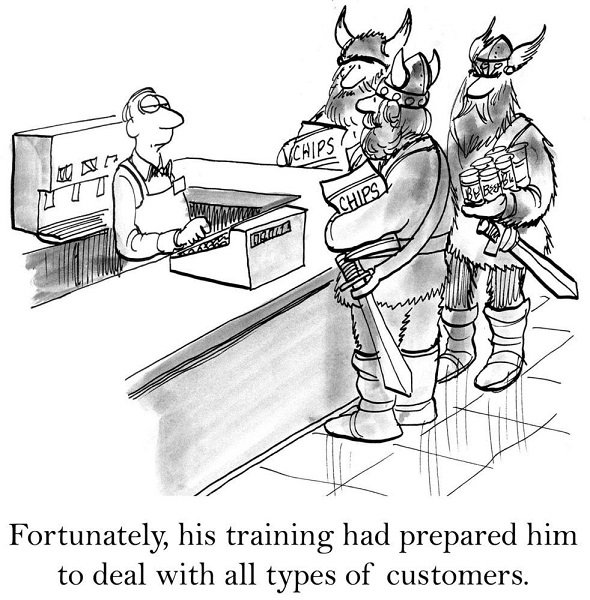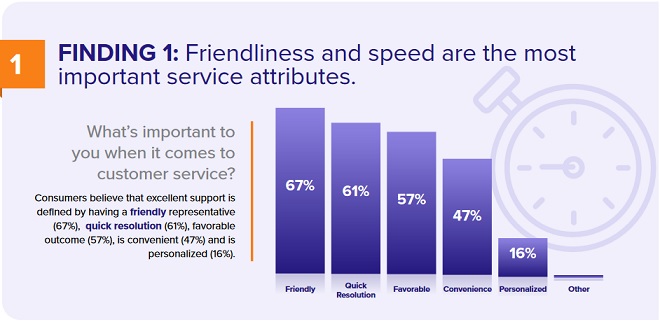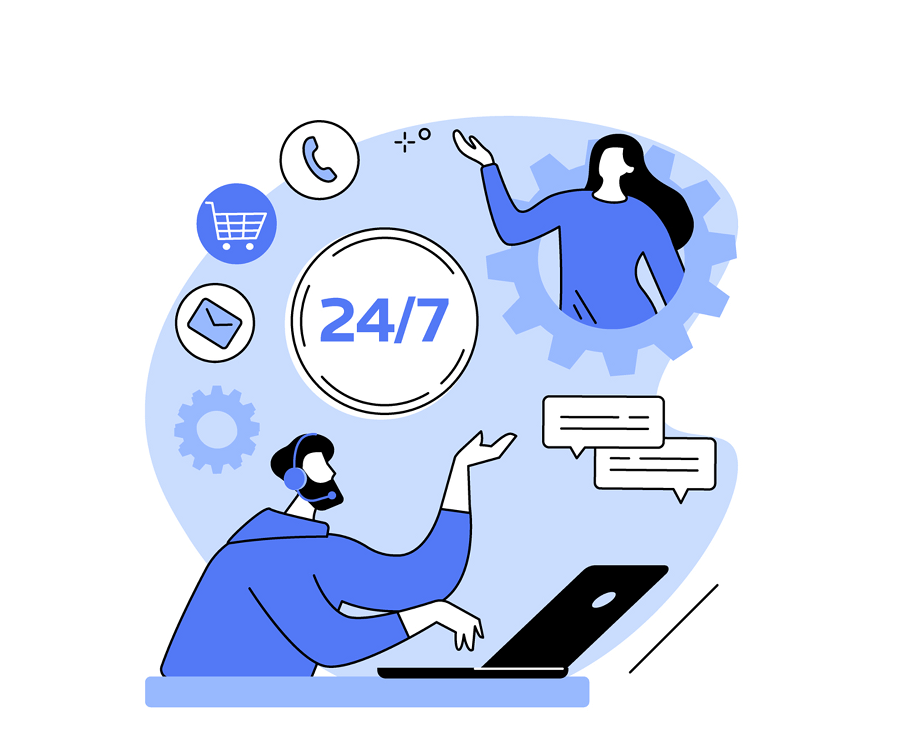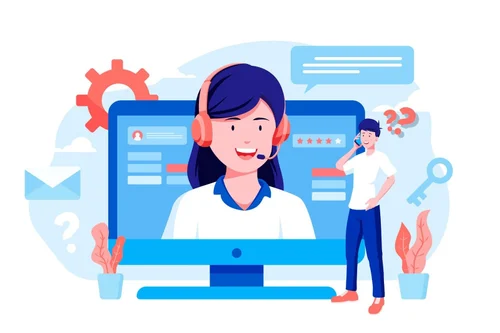
Customer service is no longer a nice-to-have feature - it's a necessity.
Modern consumers expect exceptional experiences and want organizations to resolve their issues quickly and accurately. In fact, in a 2021 study from Netomi, 96% of U.S. consumers consider having good customer service important, while 82% consider it extremely or really important.
As Jeff Bezos says, “We see our customers as invited guests to a party, and we are the hosts. It’s our job every day to make every important aspect of the customer experience a little bit better.”
So, how can you ensure your customer service team provides proactive service that creates loyal customers?
The answer lies in effective customer service training.
A customer service department with well-trained agents is crucial for any successful organization. With the right customer service training programs, you can empower your team to build lasting relationships with customers.
In this article, we’ll provide tips and strategies to help you create customer service training programs that drive results. From creating instructor-led modules to implementing continual learning, we’ll walk you through the essentials of building a successful customer service program.
Setting the Foundation for Exceptional Customer Service
Traditionally, customer support was limited to reacting to inquiries and functioning as a service desk. Unfortunately, this approach overlooked the entire customer journey. Exceptional customer service goes beyond merely addressing dissatisfied customers; it adopts a proactive approach, anticipating their questions before they arise and ultimately leading to fewer dissatisfied customers.
Understanding the Importance of Customer Service in Business
Over 65% of people have higher expectations for customer service today than three to five years ago. Additionally, 61% of consumers plan to cut discretionary spending in 2023, which shows consumers plan to be more mindful of where they spend their money.
Organizations can no longer treat customer service as an unnecessary cost; instead, they need to start recognizing it as an investment in customer retention and loyalty. With countless options available, the way a brand connects with customers through customer service can be a deciding factor.
Characteristics of Exceptional Customer Service
Imagine a customer receiving a faulty product. You have two options for handling the situation:
- Option 1: Rely on an undertrained customer service team that may struggle to understand the issue and provide a slow and inadequate resolution, leaving the customer frustrated and likely to consider other brands in the future.
- Option 2: Assign a well-trained customer service agent who can promptly and effectively address the problem, demonstrating empathy and understanding while offering a suitable solution. This personalized approach leaves the customer satisfied and more likely to remain loyal to your brand.
Which option do you think will result in a happy customer and a successful business? The answer is clear: investing in exceptional customer service and well-trained agents is essential for retaining customers and fostering brand loyalty.
And the research backs this up, as the previously mentioned study from Netomi found that excellent support is defined by having a friendly representative (67%), quick resolution (61%), favorable outcome (57%), convenience (47%), and personalization (16%).

How Customer Service Impacts the Bottom Line
Does customer service merely result in strong relationships, or do these relationships directly affect a business's financial performance?
Let's lay down some hard facts:
- Businesses prioritizing customer experience grow their revenue 1.7 times faster than those that don’t.
- Customer experience leaders see a 307% return on their stock performance.
- Businesses that value customer experience also grow their customer lifetime value by 2.3X on average.
Acquiring a new customer can cost five to seven times more than retaining an old one. Ensuring customer satisfaction reduces churn and increases lifetime value. Satisfied customers are more likely to return for bigger purchases and recommend your product to their friends and family, who, in turn, may become loyal customers themselves.
Customer service is a self-reinforcing cycle: exceptional training leads to better experiences, which result in increased satisfaction, loyalty, and ultimately, revenue growth.
Essential Customer Service Training Techniques
Customer service training programs rely on dynamic methods to provide agents with the customer service skills they need to be successful. Here are five techniques that can help your customer service teams reach excellence:
1. Active Listening and Effective Communication
At the core of customer service training is understanding and addressing customer concerns. Customer service employees deal with tense situations and must remain polite and professional. Active listening, clarifying confusing questions, speaking clearly and concisely, and responding in a friendly manner ensure customers get their desired answers.
In an episode of Customer Service Secrets by Kustomer, Matt Abrahams, author of “Speaking Up Without Freaking Out: 50 Techniques for Confident and Compelling Presenting," defines the three principles that form the foundation of effective communication:
- “Confidence: Understand the situations that make you nervous and learn how to manage them.
- Relevance: Focus on making your content relevant, specific, and useful for the people you’re speaking to by honing your content.
- Warmth and connection: Deliver your message in a way that demonstrates warmth and connection and shows your audience that you're there to collaborate and partner with them.”
2. Empathy and Emotional Intelligence
The number one source of frustration for customers dealing with support is not having their issues validated. Apologizing and demonstrating that you're hearing and acknowledging their feelings can significantly improve customer satisfaction.
Dave Murray, VP of Consulting with The DiJulius Group focuses on creating an internal culture that values empathy and incorporates it into the customer service training program.
"Encourage team members to empathize with one another and be mindful of each other's circumstances When employees practice this daily, they can extend it to customers more naturally.
Departments should identify their internal customers – colleagues or departments that rely on their services – and fully understand their needs. Although a lot of time and money are spent on customer assessments in the sales world for external customers, internal customers should not be neglected.
While we may not put the same effort into understanding internal customers, it's crucial to have a basic grasp of their wants, needs, challenges, and calls to action. Knowing what they require from us and the expected deliverables can make a significant difference."
Consider a customer's unique circumstances in each situation to provide a better solution. Inflexible policies limit a customer service rep from helping customers as much as they should. Instead, define clear internal parameters to ensure reps have the autonomy to customize solutions during customer service training.
3. Conflict Resolution and Problem-Solving
Understanding how to identify customer problems and what steps reps need to take to resolve them is essential to customer service training programs.
Roleplaying exercises, for example, can help reps understand how to navigate complex customer interactions professionally. These exercises also teach reps negative cues to be mindful of that could escalate a situation.
Dave Murray focuses on creating an internal culture that values empathy and incorporates it into the customer service training program.
"Negative cues can exist everywhere. They're not intentional, but they just creep into what we say and our body language. They provide a negative connotation to our customers.
Maybe you called your insurance company one day, and they responded by saying you need to verify your information. That's pretty standard, and you might hear that from time to time.
But if I change "verify" to you need to "confirm" your information, that statement changes the tone ever so slightly. But if I change one more word - "you" to "we" just need to confirm your information - I take the statement where I started off as a little bit accusatory, and now I'm advocating for you."
Dave Murray shows that even small changes to language and customer interactions can solve customer problems, de-escalate tense situations, and improve customer relations.
4. Time Management and Efficiency
Nearly half (47%) of people expect fast, convenient support and customer service. Similarly, nearly half (44%) of people consider waiting for a response to be a major source of frustration and annoyance. In today's fast-paced world, services are available with just a few clicks, and modern customers are no longer accustomed to waiting.
Effective time management and efficient customer service training can help representatives address customer complaints and handle multiple requests simultaneously.
Jay Baer, who’s the author of six best-selling books and has built five multimillion-dollar companies, believes that if you can give your customers the gift of time, they'll be even more likely to be loyal customers.
"In a competitive scenario, 53% of consumers have hired a business that was the quickest to respond even if they were not the least expensive because consumers now equate speed with caring."
Implementing automatic responses, pre-populated templates, and documents can streamline the customer support process, making it faster and more efficient. Reps need access to databases and resources to find the right answers to customer queries. Customer service training exercises such as simulations and roleplaying can help reps learn how to address different customer scenarios and respond quickly.
5. Product and Industry Knowledge
Customer service representatives need to be experts on the products they represent. They need comprehensive product knowledge to answer questions promptly, suggest possible alternatives for customers, and make recommendations.
These reps should also have a basic understanding of the industries they serve to better address customer needs. Continuous learning and staying informed about industry news, trends, and innovations are crucial. Learning activities such as quizzes, webinars, seminars, and workshops can help them develop their expertise in the company’s products and services.
Cross-functional collaboration with other departments (e.g., product development, marketing, sales) can enhance product and industry knowledge, providing a deeper understanding of the company's products, services, and customer needs.
For example, if your company sells email marketing solutions, customer service reps need to know the ins and outs of the tool they’re selling. They should be able to understand how customers from different industries can use it and what kind of support they may require.
This firsthand knowledge helps representatives anticipate problems and create better customer experiences. It also helps them identify common and emerging themes to see where the ‘heat’ is at. For example, if a customer service team notices that many customers have the same issue with a certain product, they can raise awareness with product teams and develop a solution.
Creating a High-Impact Customer Service Training Program
Empowering employees with a wide range of hard and soft skills ensures they can handle customer emergencies. It's also crucial for the customer service training program to be fast to address high turnover and get new employees up to speed with the company’s policies.
Take a look at the following best practices to help with training and developing your customer service representatives.
1. Set Clear Expectations and Performance Metrics
Surprisingly, many employees still feel uncertain about what is expected of them at work. This lack of clarity can negatively impact customer service performance. To ensure clarity for customer service representatives, it's important to break down job-specific tasks and responsibilities. This way, reps will know exactly what is expected of them in various customer service scenarios.
For instance, establish a clear workflow for handling customer complaints or inquiries, which could involve assessing the customer's concerns, proposing a solution, and resolving the issue. In addition to clear expectations, it's essential to introduce performance metrics, such as average resolution time, customer satisfaction scores, and first-contact resolution.
Make sure reps fully understand these metrics during training and consistently reinforce them on the job. Regularly measure and discuss these metrics in team meetings to monitor performance, identify areas for improvement, and maintain a strong focus on delivering exceptional customer service.
2. Identify Gaps in Your Current Customer Service Practices
Identifying gaps in your current customer service practices involves examining relevant data to understand your company's strengths and weaknesses.
Ask yourself questions like:
- How do customers rate the overall service they receive?
- How often are customer queries left unresolved or delayed?
- Are customers leaving the company due to poor customer service experiences?
For example, if customers on Twitter aren't receiving adequate attention from your customer service team, it's crucial to remember that social media platforms, which are often primarily used for marketing, can also serve as customer service channels. Customers will reach out to you on the platforms they feel most comfortable using and where they can find you easily. Therefore, it's crucial to analyze each customer service channel to pinpoint unique challenges and develop tailored solutions.
By addressing these gaps, you can improve the overall quality of your customer service, leading to increased customer satisfaction and loyalty
3. Personalize Training by Providing Multiple Training Formats
Your company’s success depends on its employee's ability to provide high-quality customer service. Developing a detailed, well-structured customer service training plan tailored to your staff's needs will help them understand their roles better and improve customer service.
Offer a variety of training formats such as video, e-learning, workshops, and on-the-job training to cater to different learning preferences. Ideally, you want to understand each employee's preferred learning style so that you can personalize the training to their individual needs allowing them better understand and apply the skills they learn.
It's also important to identify each employee's strengths and weaknesses and tailor the training accordingly. For example, if an employee struggles with handling angry customers, they may benefit from additional training and practice in de-escalation techniques. On the other hand, an employee who excels at problem-solving may benefit from advanced training in resolving complex customer issues.
4. Optimize the Impact of Your Training Sessions
To ensure the success of your customer service training program, it’s essential to optimize the impact of your training sessions. By using a variety of training methods and activities, you can help your employees understand as well as apply the skills they learn more effectively.
Consider incorporating the following strategies into your training sessions:
- Effective onboarding: A strong onboarding process with relevant customer service training sessions can help new employees quickly adapt to their roles. Teach reps about the mission, vision, and values of the company and provide them with practical customer service skills.
- Role-playing exercises: Role-playing exercises provide employees a safe environment to simulate customer interactions where they can experiment with different approaches to resolving customer issues. This allows them to gain valuable insights into customers’ perspectives and practice, as well as improve their communication, empathy, and problem-solving skills.
- Scenario-based training: Use real-life scenarios to help your customer service employees understand the practical application of the skills and knowledge they are learning. This approach equips them to better handle a variety of situations and challenges they may face in their roles.
Michael Podolsky, the CEO and Co-Founder of PissedConsumer.com, shares his organization's approach to hands-on training, in this case using scenario-based training:
"During training, senior managers introduce customer service employees to particular cases with real customers and teach them core techniques that help solve customers’ problems.
There is a separate part of training dedicated to handling disagreements with customers. At this training stage, customer service representatives learn about active listening and how important it is never to interrupt a customer. By truly hearing and understanding customers’ perspectives, they learn to gain insight into their feelings and needs and identify potential misunderstandings or miscommunications.”
5. Encourage Ongoing Learning, Development, and Feedback
To foster a culture of continuous improvement, it is essential to encourage ongoing learning, development, and feedback among your customer service team. By prioritizing these elements, you can ensure that employees are well-equipped to handle evolving customer needs and industry trends.
- Ongoing learning opportunities: Offer regular customer service training and development opportunities, such as workshops, seminars, or e-learning modules, to help your employees stay updated on industry trends and best practices. Encourage them to attend conferences, webinars, or other events to learn from thought leaders and experts in the field.
- Peer-to-peer learning: Create an environment that promotes collaboration and knowledge-sharing among team members. Encourage employees to share their experiences, insights, and solutions with one another, fostering a culture of continuous learning and improvement.
- Regular feedback: Implement a system for regular feedback from customers, peers, and managers. Use this feedback to identify areas of improvement and provide constructive guidance on how employees can enhance their customer service skills. Establish a transparent and supportive feedback culture that encourages open communication and enables employees to learn from their mistakes.
- Performance reviews and goal setting: Conduct periodic performance reviews to assess employees' progress and growth. You can use performance evaluation forms to set clear, achievable goals for each team member that align with the company's overall objectives. Monitor their progress and provide guidance and support to help them reach their goals.
- Professional development support: As part of your commitment to employee growth, consider offering financial assistance or other resources for additional education and training opportunities. This support demonstrates your investment in their development and can lead to a more motivated and skilled workforce.
Michael Podolsky, the CEO and Co-Founder of PissedConsumer.com, shares an example of how his organization supports employee growth:
"In our organization, we build a corporate culture that helps inspire our employees for self-development and growth. We encourage all team members to participate in R&D and always welcome ideas from everyone, no matter their level of experience. As part of our benefits package, employees get financial help on additional education and customer service training they might need to improve their customer service skills. Again, it is important as it shows our support and gives a feeling of appreciation."
By incorporating ongoing learning, development, and feedback into your customer service training program, you can create a culture of continuous improvement that ultimately leads to higher customer satisfaction and stronger employee performance.
6. Foster a Culture of Collaboration and Support
Encourage collaboration between teams and sharing of data to help drive service as a revenue driver, not just a cost center. Implement AI technologies to automate tasks and free up customer service reps to handle more complex customer problems, allowing them to focus on high-value interactions. Managers should be vigilant for signs of burnout in their employees, such as decreased motivation, irritability, difficulty concentrating, physical exhaustion, or a lack of enthusiasm.
85% of decision-makers agree that there is a direct link between employee experience and customer experience, and unhappy employees find it challenging to please customers. Create a supportive work environment by offering flexible schedules, wellness benefits, and career development opportunities to help teams stay motivated, passionate, and engaged.
7. Leveraging a Knowledge Base for Onboarding and Ongoing Training
A key component of implementing effective customer service training is utilizing a knowledge base—a centralized repository of facts, concepts, and information about the company's products or services. A well-organized knowledge base serves as a valuable training tool for customer service representatives, enabling them to quickly access relevant information and provide accurate support to customers.
During the training process, ensure that customer service representatives are familiar with the knowledge base and its content. Teach them how to navigate and search for information effectively. This familiarity will empower them to resolve customer queries more efficiently and confidently.
Regularly update and maintain the knowledge base to ensure that it remains a reliable resource for customer service reps. Encourage them to provide feedback on any gaps or inaccuracies they encounter, as their input can be invaluable in keeping the knowledge base current and comprehensive.
Incorporating knowledge base software with customer service training not only equips representatives with the information they need to excel in their roles but also enables them to focus their efforts on high-value customer interactions, ultimately enhancing customer satisfaction.
Measuring Success
When it comes to customer support team performance, the key is to set tangible goals that everyone can focus on and measure progress against. Here's what you can focus on:
Key Performance Indicator (KPIs) for Customer Service
The right metrics will help you track customer service team success. Combining qualitative and quantitative data gives you a comprehensive view of how well your team is doing, and where they can improve. Klaus, the leading customer service quality management platform, highlights the following customer service quality metrics:
- Customer Satisfaction (CSAT): The CSAT helps you measure customer satisfaction levels. You can calculate this score by asking customers to rate their overall experience on a scale from one to ten or if they’re satisfied with the service provided.
- Net Promoter Score (NPS): NPS is a more holistic measure of customer satisfaction since it analyzes how likely customers are to recommend the service to friends and family. How customers rate their overall experience with a company and how likely they are to recommend the service can help you identify areas for improvement.
- Internal Quality Score (IQS): When talking to reps, customers don't just review the individuals, they also review your product. IQS rates representatives from the company's perspective through peer-to-peer, manager, or self-reviews and defines criteria based on tone, product knowledge, and solution.
- Customer Effort Score (CES): The CES measures the effort customers have to put in to get a response or solution from the customer service team. You can measure this metric through surveys that ask customers how easy it was for them to find answers and solutions, as well as if they had to contact customer service multiple times before getting an answer.
Gather and Analyze Customer Feedback
Gathering feedback is one of the most challenging tasks for customer service teams. Support chat, 1 to 1 conversations with existing customers, 1 to 1 conversations with experts and partners who operate in the space, user testing with a small group of customers, and social media monitoring are all great ways to get honest and timely customer feedback.
Once you have the data, analyze it to determine how well your customer service team performs. Identify common and emerging themes and look for patterns in customer feedback.
Focus on causation and draw connections between the underlying insights, the problems fixed, and the solutions generated. Adopt an experimental mindset and test out different approaches. This will help you determine what works best regarding customer service delivery.
Evaluate the Effectiveness of Your Training Program
The best customer service teams are well-trained, knowledgeable, and capable of responding quickly to customers. Customer service training programs must provide reps with the right knowledge and skills to serve their customers better. Evaluate the effectiveness of your customer service training program by measuring how many reps have achieved certification in different areas, such as product knowledge, customer service processes and protocols, or customer service best practices.
Keep track of how many customers come back to purchase more products or services from your company, and use this metric to indicate whether your training program was successful. Measure how quickly customers receive a response to their queries and use this metric to assess whether reps use the knowledge they gained in training.
Make Your Customer Service Training Program a Priority
A strong customer service training program equips customer service reps with the right skills and knowledge to serve customers better. It also allows you to measure how well representatives are performing, identify areas for improvement, and ensure reps consider customer feedback.
Link your training program with customer service tools like a knowledge base to give reps easy access to the necessary information. Helpjuice allows your team to build a knowledge base accessible to reps anytime. Get in touch to learn more about how Helpjuice can provide your team with a powerful knowledge base to help them address every customer's request.


![14 Zoom Alternatives for Team-Wide Video Conferencing [2023]](https://static.helpjuice.com/helpjuice_production/uploads/upload/image/4752/direct/1586534415247-1586351118228-Zoom%20Alternatives.png)
![Guide to Training Call Center Agents [2024]](https://static.helpjuice.com/helpjuice_production/uploads/upload/image/12982/3585033/1698261103181-call-center-agent-turnover-previous-5-years-infographic.jpg)

